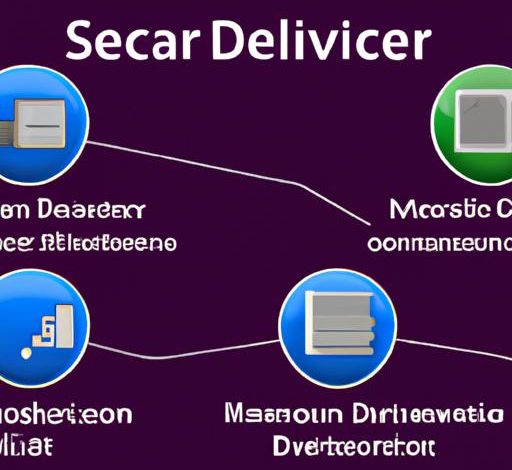Data Types in SQL Server: A Comprehensive Guide to Efficient Data Management

Introduction
In the vast realm of data management, SQL Server stands tall as a prominent player, offering robust capabilities for storing, querying, and manipulating data. However, to truly harness the power of SQL Server, one must delve into the realm of data types. But what exactly are data types, and why are they crucial in SQL Server?
As we embark on this journey, let me take a moment to introduce you to the world of data types and shed light on their significance in SQL Server.
Data types, in simple terms, define the nature of the data stored in a database. They determine the range of values, storage requirements, and operations that can be performed on the data. By choosing the appropriate data types, you can optimize storage space, ensure data accuracy, and enhance query performance.
Think of data types as the pillars of a sturdy foundation. Just as a well-constructed building relies on the strength of its foundation, an efficient database relies on the appropriate selection of data types. By understanding the intricacies of data types in sql server, you can unlock the full potential of this powerful database management system.
Stay with me as we explore the common data types in SQL Server, discover best practices for choosing the right data types, and learn how to modify them seamlessly. Together, we will navigate the vast sea of data types, ensuring your SQL Server database is sturdy, efficient, and optimized for success.
So, let’s dive in and unravel the mysteries of data types in SQL Server, one piece at a time.
Understanding Data Types in SQL Server
Definition and Role of Data Types in Database Management Systems
In the realm of database management systems, data types play a vital role in defining the characteristics and properties of the data stored within. A data type essentially determines the type of data that can be stored in a particular column of a database table. It specifies the range of values, the format, and the operations that can be performed on the data.
By assigning the appropriate data type to a column, you ensure data accuracy, optimize storage space, and facilitate efficient data retrieval and manipulation. Just as a carpenter selects the right tool for a specific task, choosing the correct data type is crucial for seamless data management in SQL Server.
The Importance of Choosing Appropriate Data Types
Choosing the right data type is akin to selecting the perfect container for storing your valuables. It can make a significant difference in terms of efficiency, performance, and resource utilization. By selecting an appropriate data type, you ensure that the database allocates the optimal amount of storage space for each column, avoiding unnecessary wastage.
Moreover, data types impact query performance. When the data type matches the nature of the data and the operations performed on it, SQL Server can leverage indexing and other optimization techniques to execute queries more swiftly. This leads to faster data retrieval and enhanced overall system performance.
Overview of Various Data Types Supported by SQL Server
SQL Server offers a wide array of data types to cater to diverse data storage and manipulation needs. Let’s take a quick tour of the commonly used data types:
- Numeric Data Types: These include integer types (e.g., int, bigint, smallint) for whole numbers and decimal types (e.g., decimal, numeric, money, smallmoney) for precise decimal values.
- Character Data Types: SQL Server provides char and varchar data types for storing variable-length character data, and text and ntext data types for larger text data.
- Date and Time Data Types: For handling dates and times, SQL Server offers date, time, and datetime data types, along with datetime2, datetimeoffset, and smalldatetime data types for specific use cases.
- Other Data Types: SQL Server also supports binary and varbinary data types for storing binary data, an XML data type for XML documents, and user-defined data types for custom data structures.
By understanding the various data types at your disposal, you can make informed decisions when designing your SQL Server database, ensuring optimal data organization and management.
Common Data Types in SQL Server
When it comes to SQL Server, a wide array of data types is at your disposal to cater to the diverse needs of your database. Let’s explore some of the most commonly used data types in SQL Server and understand their characteristics.
Numeric Data Types
Numeric data types handle numeric values, allowing precise representation of integers and decimal numbers. Within this category, SQL Server offers various options:
-
Integer data types: These data types store whole numbers without decimal places. Options include
int,bigint, andsmallint. For example, anintdata type can store values ranging from -2,147,483,648 to 2,147,483,647. -
Decimal and numeric data types: If you require precise decimal values with a defined scale and precision, these data types are your go-to choice. They include
decimal,numeric,money, andsmallmoney. For instance, thedecimal(10, 2)data type can store values with up to 10 digits, with 2 digits after the decimal point.
Character Data Types
Character data types are designed to store textual information such as names, addresses, or descriptions. SQL Server offers a range of options for character data:
-
Char and varchar data types: These data types store fixed-length and variable-length character strings, respectively. The
chardata type allocates a fixed amount of storage, whilevarchardynamically adjusts the storage based on the length of the data. -
Text and ntext data types: These data types are suitable for storing large amounts of text data.
Textstores non-Unicode characters, whilentextsupports Unicode characters. However, it’s important to note that these data types are deprecated in newer versions of SQL Server.
Date and Time Data Types
Managing dates and times efficiently is crucial in many database systems. SQL Server offers a range of data types to handle temporal information:
-
Date, time, and datetime data types: These data types allow the storage of dates, times, or both. The
datedata type stores dates without time,timestores time values, anddatetimestores both date and time information. -
Datetime2, datetimeoffset, and smalldatetime data types: These data types offer more precision and functionality for handling date and time values.
Datetime2provides higher precision,datetimeoffsetconsiders time zones, andsmalldatetimestores a date and time value with reduced precision.
Other Data Types
SQL Server also provides various other data types to cater to specific needs:
-
Binary and varbinary data types: These data types store binary data, such as images or file attachments.
Binarystores fixed-length binary data, whilevarbinaryaccommodates variable-length binary data. -
XML data type: Designed to handle XML documents, this data type allows the storage and manipulation of XML data in a structured manner.
-
User-defined data types: SQL Server enables the creation of custom data types based on specific requirements. These user-defined data types offer flexibility and encapsulate complex structures for better data management.
Now that we have explored the common data types in SQL Server, we can move forward to understanding the best practices for choosing the right data types to optimize your database’s performance and efficiency.
Choosing the Right Data Type in SQL Server
When it comes to selecting the right data type in SQL Server, several factors come into play. Let’s explore these factors and uncover the best practices for choosing data types in different scenarios.
A. Factors to consider when selecting a data type
-
Size and storage requirements: Consider the amount of space your data will occupy in the database. Choose a data type that can accommodate the size of your data without wasting unnecessary storage. For example, if you know that your data will never exceed a certain length, opt for a fixed-length data type like
charinstead of a variable-length one likevarchar. -
Data precision and accuracy: Determine the level of precision and accuracy required for your data. If you deal with financial transactions that demand high precision, consider using decimal or numeric data types instead of floating-point data types. This ensures accurate calculations without any rounding errors.
-
Performance implications: Keep in mind the performance implications of your data type choice. Some data types are more efficient for specific operations. For instance, using integer data types for primary keys or join columns can significantly improve query performance compared to using larger data types like
bigint.
B. Best practices for choosing data types in different scenarios
-
Storing dates and times: SQL Server offers various data types for storing dates and times. For dates without a time component, use the
datedata type, whereas for precise time measurements, considerdatetime2ordatetimeoffset. Choosing the appropriate data type ensures accurate date and time calculations and efficient storage. -
Handling textual data: When dealing with textual data, consider the length and nature of the text. Use
charorvarcharfor variable-length text, andtextorntextfor larger chunks of text. If your text includes non-English characters, thenvarchardata type supports Unicode characters, ensuring proper storage and retrieval. -
Working with numeric values: SQL Server provides a range of numeric data types to handle different scenarios. For whole numbers, consider
int,bigint, orsmallint, depending on the range of values. For precise decimal calculations, thedecimalornumericdata types are ideal choices. -
Storing binary data: If you need to store binary files such as images or documents, opt for the
varbinarydata type. It allows efficient storage and retrieval of binary data, ensuring your files are intact and accessible when needed.
By carefully considering these factors and following the best practices outlined above, you can confidently choose the right data types in SQL Server, ensuring optimal performance and data accuracy.
Stay tuned as we continue our exploration of data types in SQL Server and unveil more insights to enhance your data management skills.
Modifying Data Types in SQL Server
Altering data types of existing columns
In the ever-evolving landscape of database management, the need to modify data types of existing columns arises from time to time. SQL Server provides a straightforward approach to alter the data types of columns within a table. By using the ALTER TABLE statement along with the ALTER COLUMN clause, you can seamlessly modify the data type of a column.
However, it’s important to exercise caution when altering data types, as it can have implications on the existing data. Make sure to consider the following:
-
Data Compatibility: Ensure that the new data type is compatible with the existing data. Changing a data type that may result in data loss or inconsistencies should be approached with caution. Consider performing data backups before making any modifications.
-
Dependencies: Analyze the dependencies of the column being modified. If the column is referenced by other objects such as views, stored procedures, or functions, ensure that those dependencies are also updated accordingly.
Converting data types using CAST and CONVERT functions
Sometimes, you may need to convert data from one data type to another within SQL Server. This can be achieved using the CAST and CONVERT functions. These functions allow you to explicitly convert the data type of a value or expression.
The CAST function provides a generic method for converting data types. It allows you to convert data to a specified data type, ensuring compatibility and preserving the data integrity. For example, you can convert a numeric value to a string using CAST:
SELECT CAST(123 AS VARCHAR(10)) AS ConvertedValue;On the other hand, the CONVERT function provides more flexibility, allowing you to format the output using different styles. For instance, you can convert a date to a specific format using CONVERT:
SELECT CONVERT(VARCHAR, GETDATE(), 103) AS FormattedDate;Handling potential issues and considerations when modifying data types
While modifying data types in SQL Server, it’s crucial to be aware of potential issues and considerations that may arise:
-
Data Loss: Changing a data type can lead to truncation or loss of data if the new data type cannot accommodate the existing values. Always ensure that the new data type has sufficient capacity to store the data.
-
Performance Impact: Altering data types can impact query performance, especially if it involves changing the length of large columns. Consider the potential performance implications and evaluate the necessity of the modification.
By understanding the intricacies of altering data types, converting data using appropriate functions, and handling potential issues, you can confidently modify data types within SQL Server without compromising data integrity or system performance.
Conclusion
In conclusion, understanding and utilizing the appropriate data types in SQL Server is paramount for effective data management. By choosing the right data types, you can optimize storage space, ensure data accuracy, and enhance query performance.
Throughout this comprehensive guide, we have explored the world of data types in SQL Server, from numeric and character types to date and time types, and even user-defined types. We have discussed the factors to consider when selecting data types, such as size, precision, and performance implications. By adhering to best practices and considering the specific requirements of your data, you can make informed decisions that will benefit your database in the long run.
Remember, data types are the building blocks of your database’s foundation. Just as a sturdy foundation is crucial for a strong and resilient structure, choosing the right data types forms the basis for efficient data storage and retrieval. It is through this careful selection and optimization that you can truly harness the power of SQL Server.
As you embark on your data management journey, keep in mind the importance of regular evaluation and modification of data types. Adaptation and refinement are key to staying ahead in an ever-evolving data landscape.
So, whether you’re a seasoned SQL Server professional or just beginning your data management journey, embrace the power of data types and unlock the full potential of your SQL Server database.
Thank you for joining me on this exploration of data types in SQL Server. Remember, for all your data management needs, visit data.makethatpc.com. Stay curious, stay innovative, and keep making waves in the world of data!
Conclusion: So above is the Data Types in SQL Server: A Comprehensive Guide to Efficient Data Management article. Hopefully with this article you can help you in life, always follow and read our good articles on the website: data.makethatpc.com



